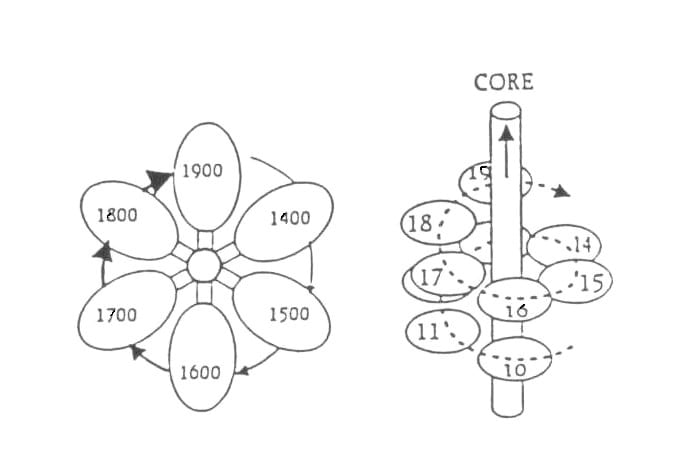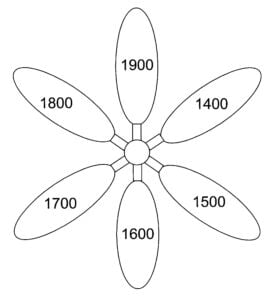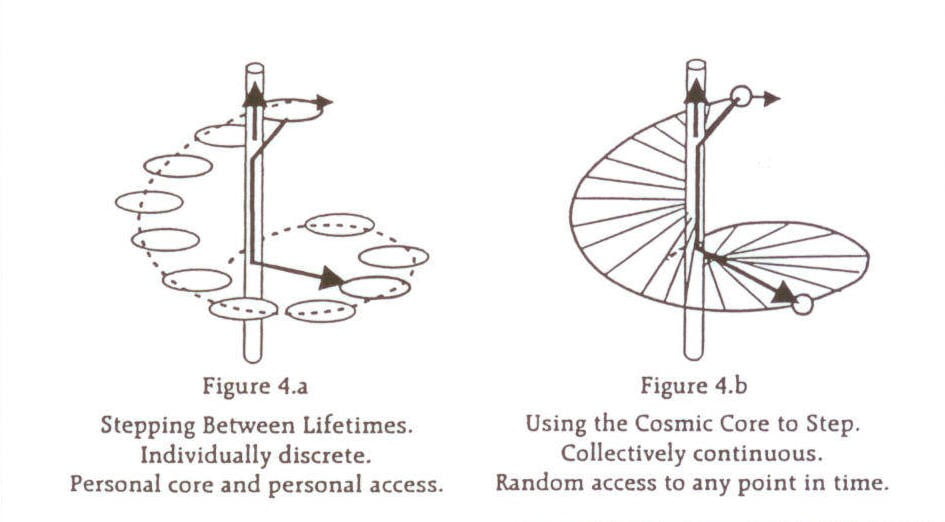David P. Armentrout, Ph.D.
The author, new to the Journal’s pages, writes “I was prompted to write this after hearing Joe Costa’s remarks about his view of time and his own regressions, made during the panel discussion at the APRT Phoenix Convention [Fall, 1998).” David has extended Joe’s ideas “a bit,” but concludes “I think Joe Costa’s guides have as good a practical explanation as I have otherwise heard, and I have tried to do them justice.” He extends Joe’s model to incorporate the findings of quantum physics regarding space and time and the infinite possibilities of the universe.
Introduction
The issue of time has never really been wholly resolved. We know that in memory we have access to everything that has happened. We know that in some cases people can accurately view the future. These ideas suggest existentially static views of time. We also know that our experience is based on sequential cause and effect linkages, a transcendental dynamic of time. These ideas seem incompatible in terms of modern materialistic physical science. However, there is a slightly more abstract approach which brings them together in a single model.
FIG 1. Flower Petal Model of Lifetimes assuming one life per century
The real world. Prior to starting this discussion, it is useful to point out that this paper, even if it were 100% correct, is not intended as a statement of Ultimate Truth. It is simply a way of looking at things. Because we perceive through finite fallible senses, imperfectly codify prior to thought, and then re-express with secondary imperfect codification, it is unlikely that anyone will ever express Ultimate Truth. Philosophers will always have something to argue about. What this paper presents is a model, a slightly more useful way of looking at time for folks doing past-life work.
At the APRT Fall 1998 Convention in Phoenix, Dr. Joe Costa remarked that his guides had told him that time could be represented much like a series of flower petals about a stem (Figure 1). One petal might be a lifetime in the 18th century, another petal a lifetime in the 10th century, and so forth.
The stem, presumably, corresponds to the general direction of the life process, and is the commonality which connects everything. In Joe’s model, time appears to be made up of discrete instants (the petals), all linked by a central core experience (the stem), and disjunct during interlife periods of no incarnation. To get from one point to another Joe had to jump from today’s petal to the core experience and then jump to a new petal. I was struck by Joe’s model, and in what follows, I develop and enlarge it.
Everyday experience teaches us that each instant of experience follows through cause and effect linkages, so that successive lifetimes must be serially connected as well as discrete. To the person living through a series of lifetimes, each lifetime seems like a stair step, isolated by a non-material interlife. This subjective impression flows from Joe’s model. However, when we look at it from the meta-perspective of all lives, we see that the actual structure is better expressed as a helix or spiral, segments of which have been experienced by one or another living system (Figure 2).

The pathway that any defined object maps as its history evolves is often called its worldline. The simplest example is to look at your own tracks in the snow, realizing that each step occurs at a different instant, expressing a different relationship with the surrounding world. The evolving definition of any object is both the confluence of prior external conditions which have followed their own worldlines, plus concurrent intermediate states which have occurred within the object itself.
For example, in the evolution of blue-green paint (Figure 3) you notice that the worldlines for yellow paint and blue paint are converging. These make green paint which is later mixed with more blue paint to make blue-green paint. With respect to the blue-green paint, all other worldlines are unused. They are there, but they are tacit, not salient in creating the blue-green paint. Everything defines everything else, so it is the network of all worldlines which makes reality a holomorphism.
Joe’s flower petal model expresses Joe’s experience exclusively, and denotes points along Joe’s worldline. When we overlay an infinite number of similar models, we get a helical structure which expresses the general experience of all living systems. In the helical model, the core experience, at the stem of the flower, is the experience of all sentient beings, the global worldline.
The probable world. Because the past is fixed, relative to each of us, the helix of past events is a rigid and invariant structure of prior activities which are linked into a network of worldlines. Getting from one point along one worldline to some other point along another worldline may be a short trip or a long way to go. Thus some transitions are more likely than others. Similarly, the nature of the future involves probabilities. We know that experience follows the path of greatest probability, but prediction of the future requires consideration of all possibilities, those which are most probable as well as those which are not very probable, to find out what is most likely.

The total amount of information defining the future is based on the total number of options which might occur. We can express this either as a collection of probabilities, or as a single global probability, or by a term describing all information about all possible relationships which form global reality. All of these ideas are properly summarized under the general term entropy. It can be shown that entropy refers equally both to information content and to probability content. Thus, when we speak of entropy we may equally be talking about the probabilities associated with something, or about the information in that thing. Thermodynamics uses entropy as one of its basic defining terms, because it is a way of describing everything which might occur in an active probabilistic system.
Reviewing the tendencies of things to interact, Hugh Everett (1957, 1973) pointed out that in rigorous quantum mechanics every possible state of existence has a real existence. Thus, not only does there exist the world in which we see one thing leading to another according to the greatest probability, but also all the other possibilities occur as well. This gives a reality in which every instant branches infinitely in every direction. The branch we follow is dictated in large part by our personal tendencies, because these shape the probability of making this or that decision. However, the other possible branches of reality exist as “parallel universes.” As an old Dahome saying puts it, “destiny is fan-shaped.”
Accepting for a moment that everything that might happen does so, we must view reality as a network or structure which expands at a rate determined by everything that can interact, and the rate at which it does so. We call that rate “time,” and sense it through interactions. There is also a type of interaction which is not an obvious part of the global tendency toward interaction, which we call “space,” but in the end they turn out to be the same thing.
The stuff of which reality is made is information, the same stuff out of which probability space is made, entropy. Life appears to us as a sequence of probabilities which lead to other probabilities, of information relating to other possible information, all of which brings us into the same conceptual space as quantum mechanics and modern physics. For those who like formalism, this idea has been worked out in much greater detail by Armentrout (1987) using a dynamic point set topology.
Place yourself at a viewpoint outside of space and time. Then the probabilities of successive moments are the connections by which the elements of one moment are linked to the elements of the next moment. From outside of space and time, “reality” might be visualized with lots of lines which link highly probable events, and very few lines which link improbable events into sequences. Because we are outside of space and time, everything is static. What we see is a network of probabilities. We can measure the information in those probability structures, which is their entropy. Aside from information, probability structures have no real nature. Thus, they are collections of information which relate to other collections of information. Ultimately, reality is not made of energy, which describes changes in relationships, nor matter, which is the structural quality containing the changing relationships, nor of the relationships, which are expressions of the differences of probabilities which change, but of entropy, which ultimately is interpreted as the simple probability of existence.
Subjective experience. Looking at a person’s life from this existential perspective we might see a viewpoint moving along one of the lines of probability, that person’s worldline. There is a definite past, a frozen history, a definition of the situation. But the future remains indefinite. Past probabilities, relative to that viewpoint, are frozen. Future choices are not yet encountered so their actual probabilities remain progressively uncertain as one looks farther into the future.
All of both past and future possible relationships have already been defined. The past is thus the collection of worldlines which have been observed by living beings, the universe which we have realized, plus parallel branches which were not experienced, unrealized parallel universes. As we move forward in the world, the past is frozen, but we carry it around as definitions of our identity. For example, the shape of your head is caused by past events frozen into solidity. The future is limited by some range of possibilities. For example, within this lifetime, it is not possible for you to sprout wings and fly. This is not determinism, but a recognition that events are linked by cause and effect sequences, and to sprout wings requires preparations which you have not as yet made. (As future options, you might have a wing implant operation or reincarnate as a bird.)
The same kind of probability structures occur for the future as for the past, but we have not as yet chosen the worldline branches which we shall follow tomorrow morning, so they are not yet fixed. They must be extensions of worldlines we followed yesterday and today, but they remain as yet uncertain. Thus, the future is also a structure, composed of entropy, through which life is able to follow various worldlines.
Physical science. These ideas work well with physical science. Time and space are defined by the number of decisions which occur between two observations. The distance measured in the binary space between (a) Me and (b) Thee, an either-or decision, is expressed with one bit of entropy. If we have a four-valued space of (a) Nowhere, (b) In Your Hand, (c) Between Us, and (d) Here On My Desk, we can express a location with two bits of entropy. The same principle extends sui generis to ultimately map the Cosmos.
Mass amounts to the number of bits of information localized in something. Motion means a change in relationships relative to the outside world. Force can now be expressed in terms of entropy changes. Force is the amount of change in the pusher which is required to cause some amount of change between the pushee and its environment, while everything moves through some common set of changes associated with a time clock. Energy is the amount of force required to make a permanent change in something while passing over some set of dimensions, hence over some set of relationships used as a spatial metric.
Potential energy implies that a change opposes the natural flow of the tendency to form relationships, so that when the causal conditions are relaxed, the object will tend to catch up, causing the delayed relationships to form. In the same way, work is the amount of change in the operating agent, perhaps a craftsman, required to produce a certain amount of change in some object, perhaps to shape wood into a table. These descriptions could continue indefinitely, but they clearly amount to little more than translation of space and time into relationships expressed in bits of entropy. There is nothing really new here except viewpoint.
Where this leads us. Return now to Joe’s flower petal model. The stem of each person’s flower is the general worldline along which that person moves. That is part of the general core experience of all humanity, which is part of the general core experience of all that exists. To get from the present time to the past, Joe moved to the core of personal experience and then out into this or that lifetime (Figure 4.a).
Let’s expand the scope of Joe’s idea. Providing that we know how, we might equally well move to the core of all experience and then out to any point within the whole manifested universe (Figure 4.b). This is not an actual motion in “time” but a review of the structural details of crystallized decisions by which we are defined, the information of which we are made. “Backwards in time” actually means “inward in structure” when we look at it existentially. We are simply looking at prior layers of entropy. These layers are divided by natural experiential markers, birth and death, the smallest increment of sensory experience, the smallest granule of matter, etc. Since we are made of information, this is no big deal. Your past-life recall of event frames is similar to examining successive layers of an onion. This is the experience of the mystic in deep meditation.
The main thing required for gaining universal awareness is a global perspective. In Eastern meditative disciplines the entire Cosmos is traced back to a single instant of self-creation out of nothingness (Khamtul, 1994; Nikhilananda, 1978). The explanations of Vedanta which tell how Prakriti, the potential for particularization, acts on Purusha, the infinite universal potentiality, to divide it into probability systems is essentially the same as the Biblical statement, “In the beginning was the Word,” but the philosophical terms are different. The ancient Egyptians used a model in which the original god Ptah masturbated himself into existence, certainly a more graphic image, but identical in meaning. Physics gives us the Big Bang, a thermodynamic version of much the same thing. No matter what creed one follows, the concept of an original instant of creation means that there is at least one point from which all the multiple branches of probability space simultaneously emerge as extensions of the initial core experience (Figure 5).

Because it is primitive to all that follows, creation, the first instant of definition, carries in itself all subsequent definitions. So from that same point, all future potentiality is already defined as the infinite and unlimited extension of that universal core experience. By meditative return to the universal core experience we can move outward to any instant in potential space and time by the same petal-core-petal method as Joe used to go back to his recent lifetimes. All that is needed is meditation to place our viewpoint at Event One, the instant of creation. By very deep hypnosis, in essence a guided meditation, this can be accomplished.
Not only does access to the universal core experience take us through all the past, but all the future as well, because all states of the Cosmos, past and future, follow from the same initial point. Of course this also reveals many futures which people will never experience because people have not made decisions as yet about which way to go. Further, decisions people might make include the effects caused by our looking at the future and telling what we see. Thus, looking into the future changes the future to include possibilities not yet known. We can never know everything yet to come because that knowledge itself changes the future.
The more we know, the more possibilities we open. The more possibilities we open, the less we understand about the ultimate meanings of our knowledge. This is a dynamic refutation of determinism and predestination. The discussion thus ends with the realization that knowledge leads to an infinite regress, and a cosmic uncertainty principle similar to Heisenberg’s Uncertainty Principle in quantum mechanics.
There is a story about three monks passing a prayer flag which waved in the breeze. The first monk thought of the prayers so vigorously being sent to heaven and said, “See how the flag moves today.” The second monk smiled, thinking in a relative way, saying, “No, it is not the flag, but the wind which is moving.” The third monk looked a bit perplexed at his companions and remarked, “Well, actually, it is only the mind which moves.”
References
Armentrout, D. An Attributive Systems Model of the Generation of Knowledge. Ann Arbor, MI: University Microfilms International, 1987.
Everett, H. Relative state formulation of quantum mechanics. Review of Modern Physics, 29: 454-462, 1957.
——— The many-worlds interpretation of quantum mechanics. in DeWitt, B. & Graham, N. (Eds.), The Many-Worlds Interpretation of Quantum Mechanics. Princeton, NJ: Princeton Univ. Press, 1973.
Khamtul (Rimpoche). Dzog Chen Meditation. Delhi: Indian Books Center, 1994.
Nikhilananda (Swami). Vedantasara of Sadananda. Delhi: Advaita Ashrama, 1978.


